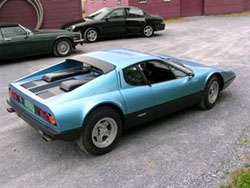Rear mid-engine, rear-wheel-drive layout


In automotive design, a RMR or Rear Mid-engine, rear-wheel-drive layout (now simply known as MR or Mid-engine, rear-wheel-drive layout) is one in which the rear wheels are driven by an engine placed just in front of them, behind the passenger compartment. In contrast to the rear-engined RR layout, the center of mass of the engine is in front of the rear axle. This layout is typically chosen for its low moment of inertia and relatively favorable weight distribution (the heaviest component is near the center of the car, making the main component of its moment of inertia relatively low). The layout has a tendency toward being heavier in the rear than the front, which allows for best balance to be achieved under braking. However, since there is little weight over the front wheels, under acceleration, the front of the car is prone to lift and cause understeer. Most rear-engine layouts have historically been used in smaller vehicles, because the weight of the engine at the rear has an adverse effect on a larger car's handling, making it 'tail-heavy'.[1] It is felt that the low polar inertia is crucial in selection of this layout. The mid-engined layout also uses up central space, making it impractical for any but two-seater sports cars. However, some microvans use this layout, with a small, low engine beneath the loading area. This makes it possible to move the driver right to the front of the vehicle, thus increasing the loading area at the expense of slightly reduced load depth.
In modern racing cars, RMR is the usual configuration and is usually synonymous with "mid engine". Due to its weight distribution and resulting favorable vehicle dynamics, this layout is heavily employed in open-wheel Formula racing cars (such as Formula One and IndyCar) as well as purpose-built sports racing cars. This configuration was also common in very small engined 1950s microcars, in which the engines did not take up much space. Because of successes in racing, the RMR platform has been popular for road-going sports cars despite the inherent challenges of design, maintenance and lack of cargo space.
History
The 1900 NW Rennzweier was one of the first race cars with mid-engine, rear-wheel-drive layout. Other known historical examples include the 1923 Benz Tropfenwagen. It was based on an earlier design named the Rumpler Tropfenwagen in 1921 made by Edmund von Rumpler, an Austrian engineer working at Daimler. The Benz Tropfenwagen was designed by Ferdinand Porsche along with Willy Walb and Hans Nibel. It raced in 1923 and 1924 and was most successful in the Italian Grand Prix in Monza where it stood fourth. Later, Ferdinand Porsche used mid-engine design concept towards the Auto Union Grand Prix cars of the 1930s which became the first winning RMR racers. They were decades before their time, although MR Miller Specials raced a few times at Indianapolis between 1939 and 1947. In 1953 Porsche premiered the tiny and altogether new RMR 550 Spyder and in a year it was notoriously winning in the smaller sports and endurance race car classes against much larger cars—a sign of greater things to come. The 718 followed similarly in 1958. But it was not until the late 1950s that RMR reappeared in Grand Prix (today's "Formula One") races in the form of the Cooper-Climax (1957), soon followed by cars from BRM and Lotus. Ferrari and Porsche soon made Grand Prix RMR attempts with less initial success. The mid-engined layout was brought back to Indianapolis in 1961 by the Cooper Car Company with Jack Brabham running as high as third and finishing ninth. Cooper did not return, but from 1963 on British built mid-engined cars from constructors like Brabham, Lotus and Lola competed regularly and in 1965 Lotus won Indy with their Type 38.
Finally, in 1966, the Lamborghini Miura was the first mid-engine, rear-wheel-drive roadcar. The concept behind the Miura was that of putting on the road a grand tourer featuring state-of-the-art racing-car technology of the time; hence the Miura was powered by a V12 transversely mounted between the rear wheels, solidal to the gearbox and differential.[2] This represented an extremely innovative sportscar at a time when all of its competitors (aside from the rear-engined Porsches), from Ferraris to Aston Martins, were traditional front-engined, rear wheel drive grand tourers.
The Pontiac Fiero was a mid-engined sports car that was built by the Pontiac division of General Motors from 1984 to 1988. The Fiero was the first two-seater Pontiac since the 1926 to 1938 coupes, and also the first and only mass-produced mid-engine sports car by a U.S. manufacturer.
Gallery
Rear mid-engine transversely-mounted, rear-wheel-drive layout
-

NW Rennzweier, first of the long line of Tatra racing cars.
-

The Lamborghini Miura, accounted as the first mid-engined roadcar.
-
The Lancia Stratos HF was powered by a mid-transverse mounted Dino Ferrari V6, and proved to be very successful as rally car.
-

The Fiat X1/9 was designed around the all-new front wheel drive Fiat 128, but used these parts in a radical way, moving the entire transverse drive train and suspension assembly from the front of the 128 to the rear of the passenger cabin.
-

As with most “rear mid-engine transversely-mounted / rear-wheel-drive layouts”, the Matra-Simca Bagheera shared Simcas 1100 and 1307 front-wheel-drive mechanicals, but placed behind the passenger compartment.[1]
-

In the Lotus Evora, platform and mechanicals are uniquely designed for the vehicle.
- ^ "Matra-Simca Bagheera". Simca Talbot Information Centre – Simca Club UK. Retrieved 2006-08-19.
Rear mid-engine longitudinally-mounted, rear-wheel-drive layout
-

The Porsche 550 Spyder produced from 1953-1956.
-

Renault 5 Turbo by predecessor Renault 5.
-

Porsche 914 shared VW mechanicals and was sold in Europe as the VW-Porsche 914.
-
The Porsche Boxster could be considered a successor to the 914.
-

Porsche Cayman based on the Boxster
-

The 1973 365 GT4 BB, Ferrari's first mid-engined GT car
-

The Ferrari Mondial, world's only production 4 seat mid-engined convertible.



